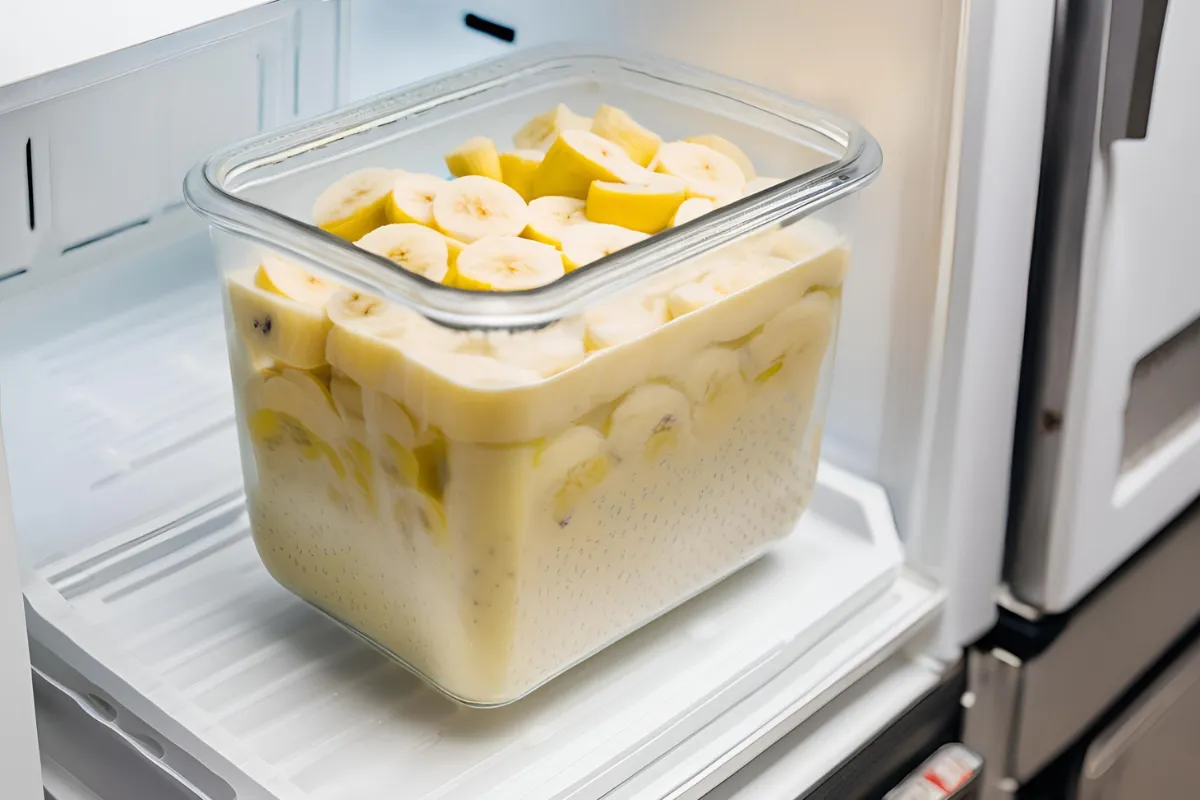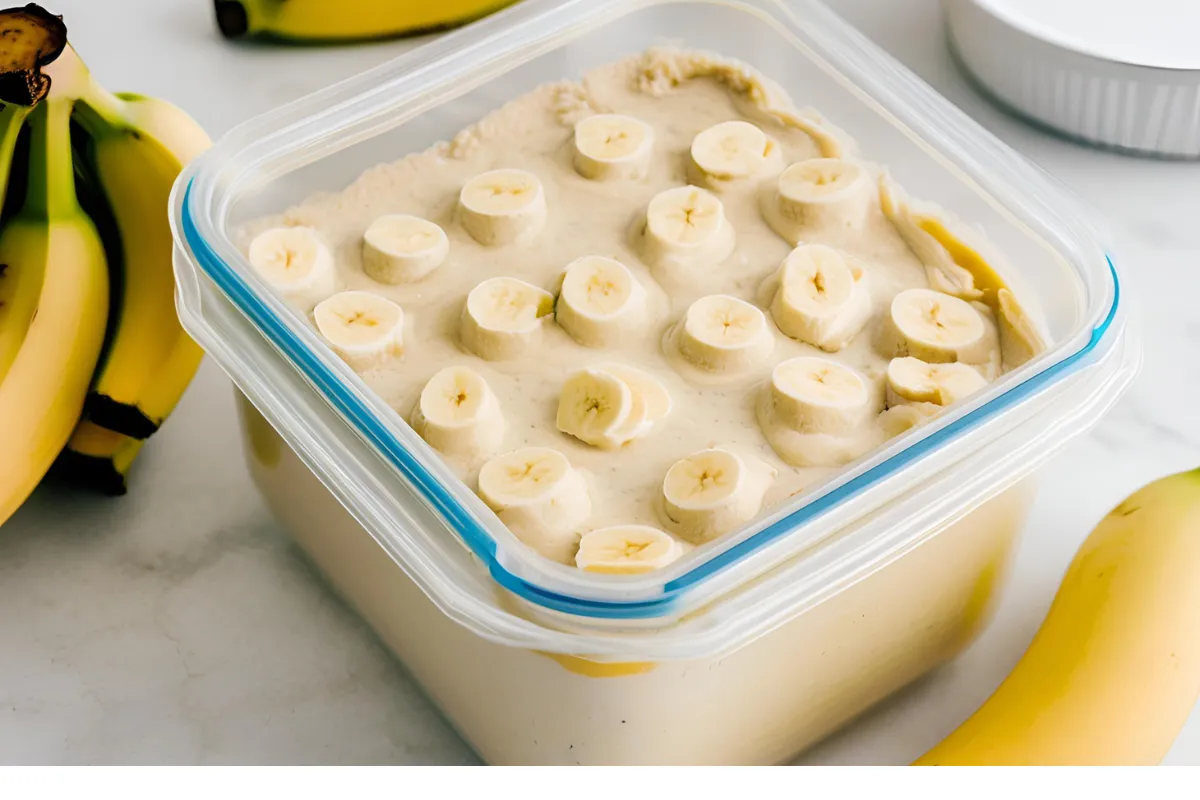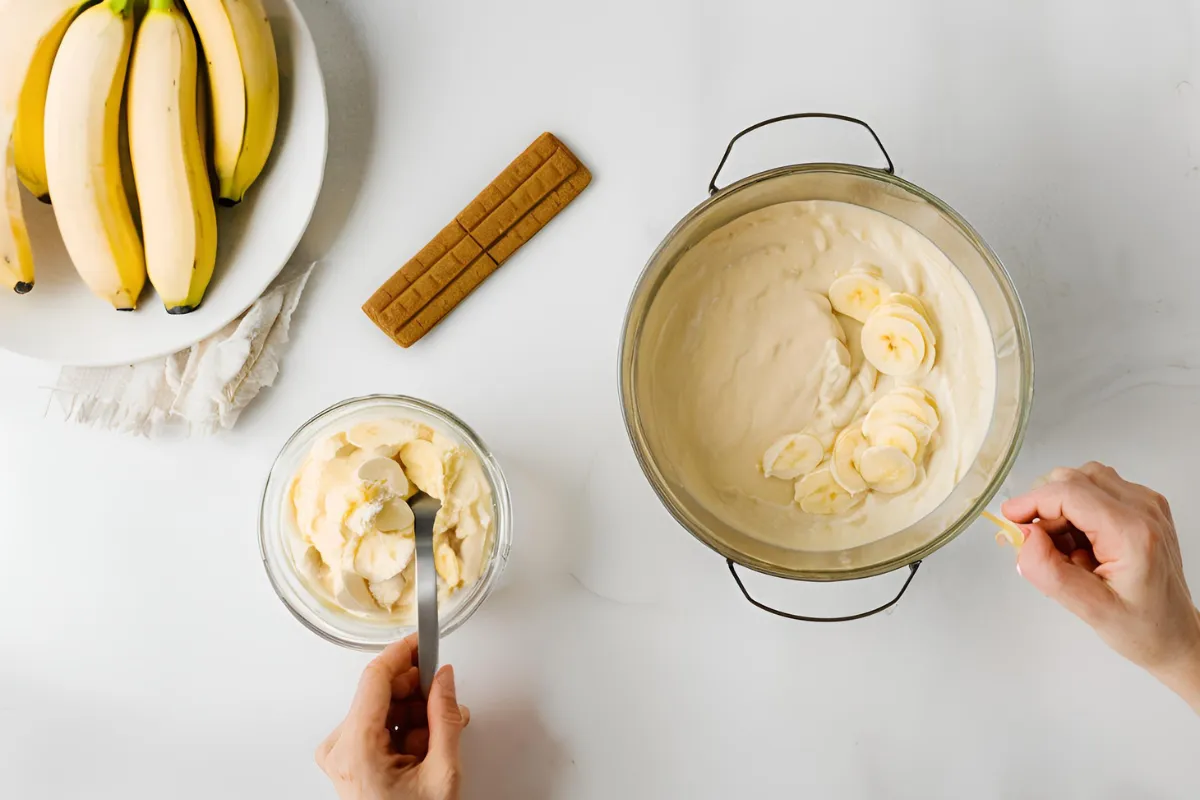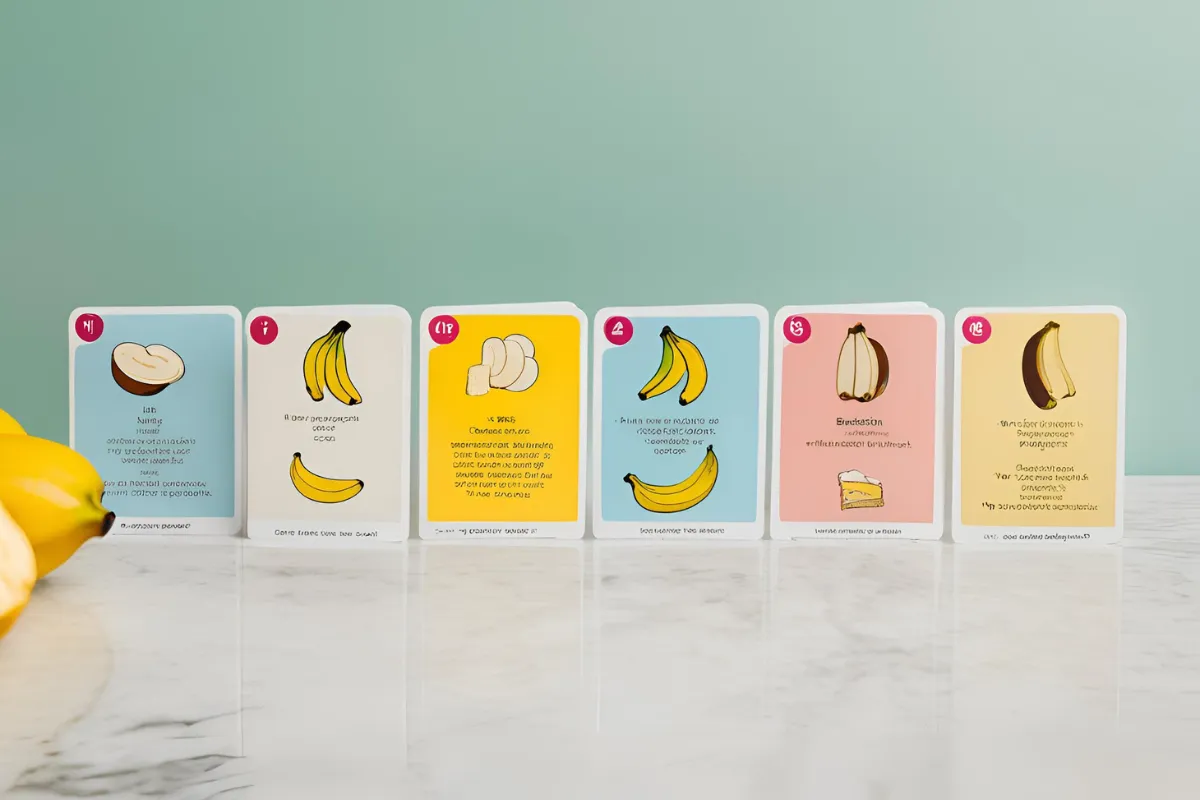Introduction
Does banana pudding need to be refrigerated overnight? This classic dessert raises questions about the best way to store it for optimal taste and texture. Many home bakers wonder if refrigeration is necessary or if it can simply sit on the counter. The way you store banana pudding can make a big difference in its freshness and consistency.
In this article, we’ll explain why refrigerating banana pudding overnight is essential. We’ll explore the science behind proper storage to keep it delicious and safe. Let’s dive into the key factors that affect the texture and flavor of banana pudding.
What is Banana Pudding?
Banana pudding is a sweet, creamy dessert made from layers of vanilla pudding, fresh bananas, and vanilla wafers. Its simple ingredients make it popular for all ages, but the rich texture elevates the dish. The pudding base is made with milk, sugar, eggs, and cornstarch (or store-bought mix), while bananas and cookies add flavor and texture.
Though banana pudding is easy to make, it requires careful storage. Leaving it at room temperature too long can alter its texture and pose food safety risks. Refrigeration is key to maintaining its quality.
Why the Question of Refrigeration Arises
Banana pudding contains ingredients that are sensitive to temperature changes. Bananas themselves can turn brown and mushy when left out too long, and the creamy pudding base can become runny if not stored properly. Additionally, like many other desserts that contain dairy, banana pudding needs to be kept at a safe temperature to avoid potential bacterial growth. This is why the question of whether to refrigerate banana pudding overnight is so crucial.
If you’ve made banana pudding before, you probably noticed how different it can be if left out for several hours. Refrigerating it helps preserve the pudding’s texture and flavor, keeping it fresh until you’re ready to serve. But how long does it really need to be refrigerated? And what happens if you don’t follow the proper refrigeration steps?
Overview of the Article
This article covers everything you need to know about storing banana pudding. We’ll discuss refrigeration, texture, and best practices. We’ll answer common questions about storage time and how refrigeration affects freshness. Plus, we’ll share tips for making perfect banana pudding.
The Role of Refrigeration in Banana Pudding
When it comes to desserts, banana pudding is undeniably one of the most comforting, creamy treats you can serve. But as much as it’s a crowd-pleaser, banana pudding also comes with some food safety considerations that you should never overlook. The simple act of refrigeration plays a crucial role in ensuring your pudding stays fresh, safe, and delicious. Let’s dive into the importance of refrigerating your banana pudding, and explore how it affects both its food safety and texture.
The Importance of Refrigeration for Food Safety
Refrigeration isn’t just about keeping your banana pudding cool — it’s about keeping it safe to eat. Like many dairy-based desserts, banana pudding is prone to bacterial growth if left out for too long. Dairy ingredients, including milk, heavy cream, and even the whipped cream topping, provide the perfect environment for bacteria to thrive at room temperature. Without refrigeration, your banana pudding can become a breeding ground for harmful microorganisms that lead to foodborne illnesses.
Refrigerating banana pudding immediately after preparation helps slow down bacterial growth, ensuring that it remains safe to consume. The low temperature inhibits bacteria like Salmonella or E. coli, which can grow in warm conditions and make you sick. This is especially important if you’re preparing banana pudding ahead of time, for instance, the night before a party or family gathering. Simply put, cooling banana pudding properly preserves both its safety and its flavor.
What Happens to Banana Pudding Without Refrigeration?
Now, let’s take a look at what happens if banana pudding is left at room temperature for too long. If you’ve ever left a bowl of pudding on the counter for hours, you know that it doesn’t stay as fresh or appetizing as when it’s first made. In fact, without refrigeration, banana pudding spoilage can set in quickly. The milk and cream in the pudding base are highly susceptible to bacterial growth, which can cause the dessert to spoil.
But spoilage isn’t the only issue. The texture of banana pudding is another area that can be significantly affected by improper storage. When left out at room temperature, the pudding may begin to separate, causing the creamy texture to break down into a watery mess. Additionally, the bananas can turn mushy and brown, further altering the pudding’s overall appeal. So, if you’re thinking of leaving it on the counter, it’s best to reconsider — room temperature pudding doesn’t last long, and the quality quickly declines.
Another consequence of leaving banana pudding unrefrigerated is the potential for banana browning. Bananas oxidize and turn brown when exposed to air, especially when not kept at a cool temperature. If your banana pudding sits out too long, you could end up with a dessert that’s not only unsafe to eat but also unattractive and unappetizing.
How Refrigeration Affects Banana Pudding Texture
While refrigeration is a must for food safety, it also has a big impact on the texture of banana pudding. At first glance, you might think refrigeration could make the pudding stiff or cause it to lose its creamy consistency. But in reality, the opposite happens: refrigeration helps maintain that smooth, velvety texture that makes banana pudding so irresistible.
As banana pudding chills, the pudding base thickens slightly, making it firmer and easier to serve. The creamy pudding texture is preserved, while the vanilla wafers soften just enough to blend with the pudding without turning into a soggy mess. On the other hand, if you skip refrigeration, the pudding could lose its consistency, becoming too runny or watery. The cooling process also allows the flavors to meld together, making the pudding taste even better the longer it sits in the fridge. So, refrigerating banana pudding overnight not only ensures it’s safe to eat but enhances its flavor and texture, leaving you with a dessert that’s as delicious as it is safe.
How Long Should Banana Pudding Be Refrigerated?
As with most chilled desserts, there’s an ideal duration for refrigerating banana pudding to ensure it stays fresh without overdoing it. Generally speaking, it’s recommended to refrigerate banana pudding for at least 4–6 hours before serving. This allows enough time for the flavors to develop and the pudding to reach its optimal texture. However, if you’re planning to make banana pudding the night before an event or meal, you can easily leave it in the fridge overnight. Overnight refrigeration ensures the pudding is fully chilled and ready to serve when you need it.
The key here is not just refrigeration, but timing. If you refrigerate banana pudding for too long (beyond 24 hours), the texture may begin to change. The bananas can become overly soft, and the vanilla wafers could lose their structure, turning into a mushy mess. To get the best results, aim to serve the pudding within 24 hours of refrigeration for maximum freshness and flavor.
In conclusion, banana pudding absolutely needs to be refrigerated overnight to maintain its safety, texture, and flavor. Proper cooling helps preserve the creamy consistency while also preventing spoilage, ensuring that every bite is just as delicious as the first. So next time you whip up a batch, be sure to store it in the fridge — you’ll be glad you did!
Best Practices for Storing Banana Pudding
Banana pudding is one of those desserts that gets even better after some time in the fridge, but storing it the right way is essential to keep its flavor, texture, and overall quality. Whether you’re preparing it for an event, making it ahead of time, or simply enjoying leftovers, following the best storage practices will ensure your banana pudding stays fresh and delicious. Let’s go over the key tips for storing this classic dessert, including the best containers to use, how to store it with bananas, and some advice on freezing and reheating.
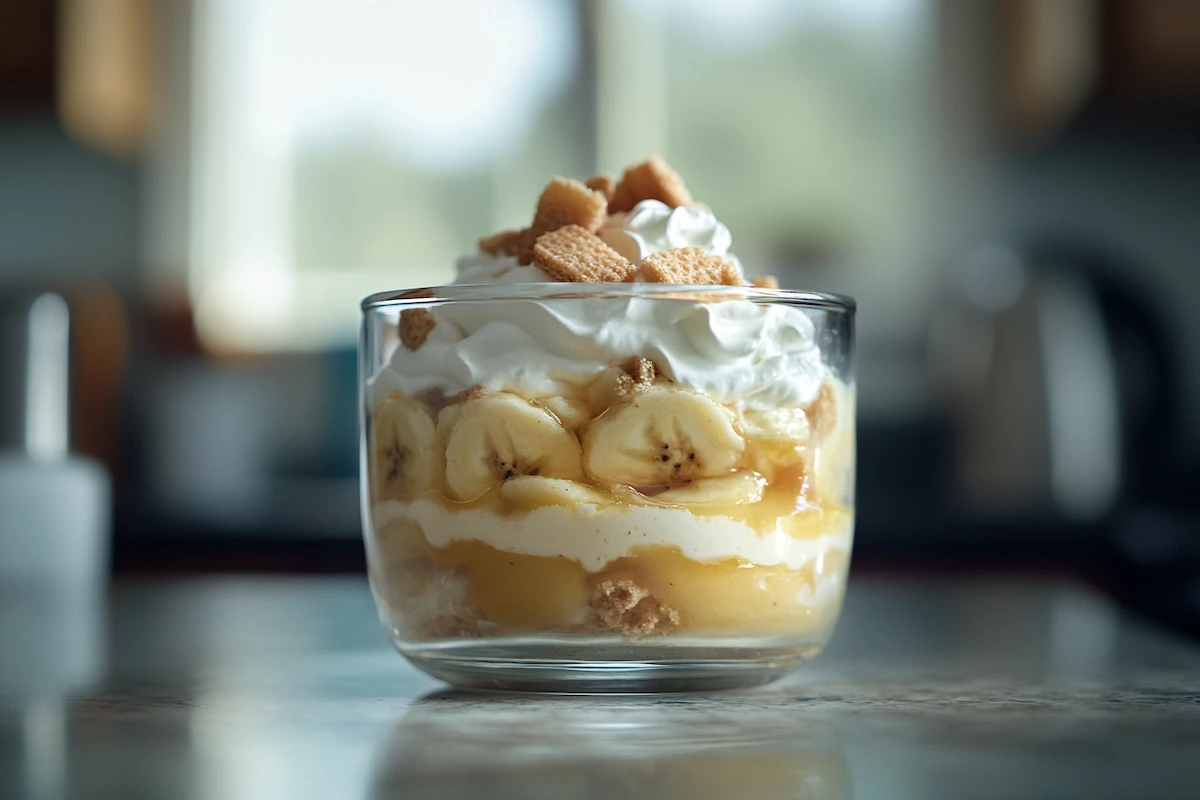
Storage Containers for Banana Pudding
When it comes to refrigerating banana pudding, the container you choose can make a significant difference in maintaining its freshness. Ideally, you’ll want to store your banana pudding in an airtight container. This helps preserve its creamy consistency by preventing moisture loss and minimizing exposure to air, which can cause the pudding to dry out or develop a skin on top.
There are a few options you can consider when selecting a storage container. Glass containers with airtight lids are a great choice because they don’t absorb odors and offer a clear view of the dessert. You can also use plastic containers with secure, airtight seals, which are convenient for both storage and transport. If you’re opting for plastic, make sure it’s food-grade and safe for refrigeration. To keep the pudding fresh for longer, avoid using containers that aren’t properly sealed, as this can allow air to seep in and affect the quality.
Additionally, be sure the container is large enough to hold the pudding without crowding. This will give the dessert room to stay intact, ensuring the layers of pudding, bananas, and wafers remain properly aligned and don’t get squished. If you’ve made a large batch, consider dividing it into smaller portions to help preserve freshness and make serving easier.
How to Store Banana Pudding with Bananas
Bananas are one of the trickiest ingredients in banana pudding when it comes to storage. While they add a delicious, soft sweetness to the dessert, they also brown quickly when exposed to air. To prevent bananas in pudding from turning an unappealing shade of brown, there are a couple of tricks you can use.
First, make sure to refrigerate the pudding as soon as possible after preparation. The colder temperature helps slow down the oxidation process that causes the bananas to brown. Some people also use a lemon juice solution to coat the banana slices before layering them in the pudding. The acidity of lemon juice can slow down the browning process. However, be cautious not to use too much, as it could alter the flavor of your dessert.
Another method is to layer the bananas in between the pudding mixture and the vanilla wafers. This helps create a barrier between the bananas and the air, reducing their exposure. If you have leftover banana pudding, keep it tightly covered in the fridge and try to consume it within 24 hours for the best banana preservation in desserts.
Can You Freeze Banana Pudding?
While refrigeration is the best option for storing banana pudding, you might wonder if you can freeze it. The short answer is yes, but with a few caveats. Freezing banana pudding is an option, but it’s not ideal for maintaining the perfect texture. When you freeze banana pudding, the texture of banana pudding can change. The pudding may become grainy or watery once thawed, especially if it’s made with a custard or pudding base.
Another challenge is the bananas themselves. Freezing them can make them mushy and unappealing when thawed, which affects the overall quality of the pudding. If you do choose to freeze banana pudding, try to remove the bananas before freezing and add fresh slices when you’re ready to serve. Freezing banana pudding in individual portions is also a good idea, as it allows you to defrost only what you need. Overall, while can banana pudding be frozen is possible, it’s best enjoyed fresh or refrigerated.
Is It Necessary to Refrigerate Banana Pudding Overnight?
You may be wondering if it’s absolutely necessary to refrigerate banana pudding overnight. The answer is yes! Refrigerating banana pudding overnight provides several benefits. First and foremost, it ensures banana pudding overnight storage preserves the freshness of the dessert, preventing any bacterial growth that could occur if it were left at room temperature for too long. Additionally, overnight refrigeration gives the flavors time to meld, enhancing the taste and making it even more delightful.
The longer you let the pudding sit in the fridge, the better the banana pudding consistency becomes. The vanilla wafers have time to soften just enough to absorb the pudding without losing their shape. While you can refrigerate banana pudding for a shorter period, refrigerating it overnight is the best way to ensure it reaches its optimal flavor and texture.
How to Reheat Banana Pudding (If Needed)
While banana pudding is typically served cold, there may be times when you want to reheat it slightly, especially if you prefer it at room temperature or just a little warmer. However, it’s essential to know how to reheat banana pudding without ruining its texture.
First, it’s important to note that you should never microwave banana pudding directly for long periods, as this can cause it to become lumpy or curdled. Instead, gently warm it up in the microwave in short intervals, stirring it between each, to ensure even heating. Alternatively, you can reheat it using a stovetop on low heat, stirring constantly to maintain its smooth, creamy pudding texture. You might also need to add a tiny bit of milk or cream if it has thickened too much while refrigerated.
When reheating, always make sure to remove the banana slices beforehand to prevent them from becoming mushy. Once it’s warmed to your liking, you can add fresh banana slices for a rejuvenated dessert experience.
Tips for Making the Perfect Banana Pudding
Banana pudding is a timeless dessert, but crafting the perfect banana pudding involves more than just mixing a few ingredients. From selecting the right bananas to adding the perfect flavor variations, every step plays a role in ensuring that your dessert turns out to be a crowd-pleaser. Here are some tips to help you elevate your banana pudding game and avoid common pitfalls along the way.
Choosing the Right Bananas for Banana Pudding
One of the most important aspects of banana pudding is choosing the right bananas. The bananas you select can significantly impact the taste and texture of the pudding. Ideally, you want bananas that are ripe but not overly ripe. Ripe bananas offer the perfect balance of sweetness and firmness, making them ideal for layering in your pudding. Overripe bananas, while sweet, can turn mushy and brown too quickly, affecting both the texture and visual appeal of the pudding.
When selecting bananas for your pudding, look for bananas that are yellow with just a few brown spots. These bananas are perfect for banana pudding, providing just the right amount of sweetness without becoming overly soft or mushy. Avoid green bananas, as they tend to be too firm and lack the natural sweetness that makes banana pudding so delicious. Proper banana selection is key to ensuring your dessert maintains that beautiful, soft banana texture without being too gooey or overly ripe.
Using the Right Pudding Mix or Making It from Scratch
Another crucial decision in making banana pudding is whether to use a banana pudding mix or prepare the pudding from scratch. Both options have their merits, and the choice depends on your time and preferences.
Using a boxed pudding mix is the quickest and easiest way to prepare banana pudding. These mixes are convenient and deliver a smooth, creamy texture with minimal effort. However, they may contain preservatives and artificial flavors, which could affect the overall taste. For many, using a banana pudding mix offers convenience but may lack the rich, homemade flavor of a more traditional recipe.
On the other hand, making homemade pudding from scratch involves a bit more work but yields a much more decadent, rich pudding base. A scratch-made pudding recipe allows you to control the ingredients, resulting in a custard-like texture with more depth of flavor. If you have the time, homemade pudding is often the way to go for the best flavor and consistency, especially if you’re aiming for an indulgent, truly perfect banana pudding.
Add-Ins to Enhance Banana Pudding
The classic banana pudding recipe uses bananas, vanilla pudding, and vanilla wafers. However, variations can enhance flavor and texture. Whipped cream adds a light, airy texture that contrasts with the creamy pudding.
Some add sweetened condensed milk or cream cheese to the pudding mix for extra richness. Vanilla wafers are traditional, but shortbread cookies or graham crackers work too. For a twist, try adding chocolate chips or crushed toffee.
Whether you stick with the classic or try new toppings, creativity can transform banana pudding into something truly special.
Serving Banana Pudding: When to Serve It
Banana pudding is one of those desserts that often gets better with time, especially after being refrigerated overnight. The timing of serving banana pudding is crucial to ensuring that the layers have had enough time to set, and the flavors have had a chance to meld together. For best results, aim to refrigerate the pudding for at least 4-6 hours, but overnight refrigeration is ideal for achieving the perfect consistency.
If you’re planning to serve the pudding the same day, be sure to allow it enough time to chill in the fridge. Don’t rush it — you want the pudding to be nice and cold before serving, so the layers of banana slices and vanilla wafers have time to absorb the pudding and soften to perfection. If you try to serve banana pudding too soon, the texture of banana pudding may not be as smooth, and the bananas may not be as integrated into the pudding. So, give it that time in the fridge for the best flavor and texture.
Troubleshooting Common Banana Pudding Issues
Even the best banana pudding makers can run into a few issues along the way. Here are some common problems and tips for fixing banana pudding:
- Watery Pudding: If your pudding is too runny, it may be because the pudding base didn’t set properly. If using a banana pudding mix, make sure to follow the package instructions carefully and let it cook long enough to thicken. For scratch-made pudding, you may need to increase the cooking time slightly. You can also try adding a bit more cornstarch to help it thicken.
- Banana Discoloration: If your bananas turn brown too quickly, try adding a small amount of lemon juice to the banana slices before layering them in the pudding. The acid in the lemon juice can help slow down the browning process without affecting the flavor. Alternatively, layering the bananas in between the pudding and wafers will keep them covered and reduce their exposure to air.
By keeping these tips in mind, you’ll be well on your way to creating the perfect banana pudding that’s not only delicious but also visually appealing and free from common mistakes.
FAQs
Banana pudding is a beloved dessert, but as with all food, it comes with its own set of questions about storage, safety, and freshness. Here are some of the most frequently asked questions about banana pudding, along with helpful answers to ensure your dessert remains both delicious and safe to eat.
How long can banana pudding sit out before it spoils?
Banana pudding should not sit out at room temperature for more than 2 hours. The dairy-based pudding and bananas are particularly susceptible to bacterial growth when left in a warm environment. After this time, the risk of foodborne illness increases. Always refrigerate your banana pudding as soon as possible after serving to ensure it remains safe to eat.
Can you eat banana pudding the next day?
Yes, you can definitely eat banana pudding the next day! In fact, overnight refrigeration often improves the flavor and texture. The vanilla wafers absorb more of the pudding, softening and melding with the bananas and creamy pudding base. Just make sure to store it properly in an airtight container in the fridge to maintain its freshness.
Why does banana pudding get watery after refrigerating?
If your banana pudding becomes watery after refrigeration, it’s likely due to one of two reasons. First, the pudding may not have set properly during preparation, which can result in a runny consistency after cooling. Second, the bananas themselves release moisture over time, especially when they’re layered in the pudding. To avoid this, make sure to layer the bananas in between the pudding and wafers or use fresh bananas right before serving. If the pudding is too watery, you can thicken it with a little cornstarch or let it chill longer to allow it to firm up.
How do you store banana pudding to keep it fresh?
The best way to store banana pudding is in an airtight container in the refrigerator. This will help preserve the creamy texture of the pudding while preventing the bananas from browning or the pudding from drying out. It’s also a good idea to cover the surface of the pudding with a piece of plastic wrap to prevent air exposure. If you plan to store banana pudding for more than a day, consider removing the bananas before storing and adding fresh slices when you’re ready to serve.
How long can banana pudding sit out?
Banana pudding can safely sit out for about 2 hours at room temperature. After that, it should be refrigerated to avoid potential spoilage. If the room is particularly warm, such as in summer or at a picnic, it’s best to refrigerate it sooner to keep it safe. Leaving banana pudding at room temperature for too long can increase the risk of bacterial growth due to the dairy and fruit components.
Can you eat pudding that was left out overnight?
No, it’s not safe to eat pudding that has been left out overnight. Like other dairy-based desserts, banana pudding should be refrigerated within 2 hours of preparation. Leaving it out overnight can lead to the growth of harmful bacteria, making the pudding unsafe to consume. For both safety and freshness, always store banana pudding in the fridge if you’re not serving it right away.
Will bananas turn brown in banana pudding overnight?
Yes, bananas can start to brown when left in banana pudding overnight. Bananas are naturally prone to oxidation, which causes them to turn brown when exposed to air. To minimize this, you can coat the banana slices in lemon juice before layering them in the pudding. Alternatively, you can layer the bananas between the pudding and wafers to help protect them from the air. While the bananas may still brown slightly, the pudding will generally hold up well in the fridge overnight.
What is the best way to store banana pudding?
Store banana pudding in an airtight container in the fridge. This keeps it fresh and prevents drying out. Cover the top with plastic wrap or parchment paper to reduce air exposure. Refrigerate promptly if storing with bananas. Consume within one or two days for the best texture and flavor.
Conclusion
Refrigerating banana pudding overnight is essential for safety and quality. It prevents bacterial growth and enhances texture and flavor.
By chilling the pudding, the base thickens to its ideal consistency. It also prevents bananas from browning quickly. Overnight storage keeps the pudding creamy, fresh, and ready to serve.
For best results, store banana pudding in an airtight container in the fridge. If serving the next day, chill it for 4–6 hours or overnight. This helps blend the flavors and perfect the texture.
Whether you follow a classic recipe or try variations, refrigeration ensures your dessert stays fresh and delicious. Remember, refrigerating overnight is the key to serving perfect banana pudding!

